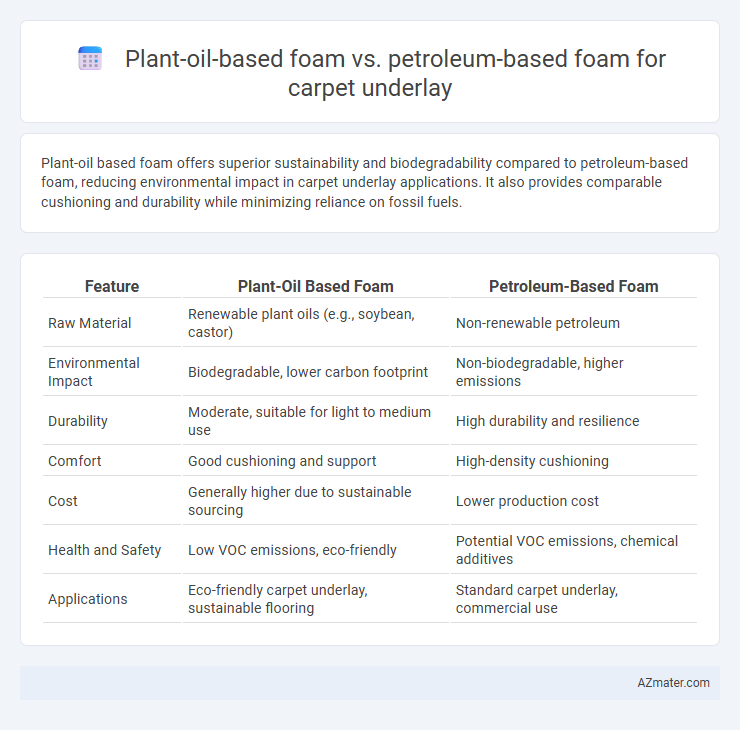Plant-oil based foam offers superior sustainability and biodegradability compared to petroleum-based foam, reducing environmental impact in carpet underlay applications. It also provides comparable cushioning and durability while minimizing reliance on fossil fuels.
Table of Comparison
| Feature | Plant-Oil Based Foam | Petroleum-Based Foam |
|---|---|---|
| Raw Material | Renewable plant oils (e.g., soybean, castor) | Non-renewable petroleum |
| Environmental Impact | Biodegradable, lower carbon footprint | Non-biodegradable, higher emissions |
| Durability | Moderate, suitable for light to medium use | High durability and resilience |
| Comfort | Good cushioning and support | High-density cushioning |
| Cost | Generally higher due to sustainable sourcing | Lower production cost |
| Health and Safety | Low VOC emissions, eco-friendly | Potential VOC emissions, chemical additives |
| Applications | Eco-friendly carpet underlay, sustainable flooring | Standard carpet underlay, commercial use |
Introduction to Carpet Underlay Materials
Plant-oil based foam carpet underlays utilize renewable resources such as soybean or castor oil, offering improved environmental sustainability compared to petroleum-based foams derived from non-renewable fossil fuels. These bio-based foams typically provide comparable cushioning, thermal insulation, and sound absorption properties essential for carpet underlays while reducing carbon footprints and off-gassing of harmful volatile organic compounds (VOCs). Advances in plant-oil chemistry enhance durability and resilience, making plant-oil foams an increasingly viable and eco-friendly alternative in flooring applications.
What is Plant-Oil Based Foam?
Plant-oil based foam is a sustainable alternative to petroleum-based foam, derived from renewable natural oils such as soybean, castor, or palm oil, used in carpet underlays for enhanced environmental benefits. This type of foam offers comparable durability and cushioning while reducing dependence on fossil fuels and lowering carbon emissions during production. Its biodegradable properties contribute to a reduced ecological footprint, making it a preferred choice in eco-friendly flooring solutions.
Petroleum-Based Foam: An Overview
Petroleum-based foam, commonly derived from crude oil, has been the traditional choice for carpet underlay due to its durability, cushioning, and cost-effectiveness. This synthetic material offers excellent insulation and moisture resistance, contributing to the longevity and comfort of carpets. However, petroleum-based foam poses environmental concerns such as non-biodegradability and reliance on finite fossil resources, prompting the search for sustainable alternatives like plant-oil based foams.
Environmental Impact Comparison
Plant-oil based foam for carpet underlay significantly reduces carbon footprint by utilizing renewable resources and biodegradable components, unlike petroleum-based foam which relies on finite fossil fuels and generates persistent environmental pollutants. Lifecycle assessments reveal plant-oil foams emit lower greenhouse gases and contribute less to landfill waste due to their enhanced recyclability and compostability. Transitioning to plant-oil based underlays supports sustainable forestry and agricultural practices, promoting circular economy principles in the flooring industry.
Health and Indoor Air Quality
Plant-oil based foam for carpet underlay significantly reduces volatile organic compound (VOC) emissions, promoting healthier indoor air quality compared to petroleum-based foam. The biobased composition minimizes the release of harmful chemicals like formaldehyde and benzene, lowering risks of respiratory irritation and allergic reactions. Enhanced moisture regulation properties in plant-oil foams also help prevent mold growth, contributing to improved home environment health.
Durability and Performance Differences
Plant-oil based foam for carpet underlay offers enhanced biodegradability and resilience, reflecting sustainable material advancements while maintaining competitive compression strength and recovery rates compared to petroleum-based foam. Petroleum-based foam typically provides higher initial durability and resistance to wear under heavy foot traffic, benefiting from well-established polymer formulations optimized for long-term performance. Performance differences hinge on application context, with plant-oil foams showing improved environmental impact and adequate cushioning, whereas petroleum foams excel in longevity and structural integrity over extended periods.
Cost Analysis: Plant-Oil vs Petroleum Foams
Plant-oil based foams for carpet underlay typically incur higher initial costs due to raw material prices and specialized manufacturing processes compared to petroleum-based foams, which benefit from established production infrastructure and economies of scale. However, plant-oil foams offer long-term economic advantages by reducing environmental compliance expenses and enhancing sustainability credentials, appealing to eco-conscious consumers and markets. Lifecycle cost assessments reveal plant-oil foams may provide cost savings in waste management and regulatory fees, offsetting upfront investment differences.
Sustainability and Renewability Factors
Plant-oil based foam for carpet underlay offers superior sustainability due to its origin from renewable resources like soy or castor oil, reducing dependence on finite petroleum reserves. It generates lower greenhouse gas emissions during production and end-of-life disposal compared to conventional petroleum-based foam, which relies on fossil fuels and contributes significantly to environmental pollution. The biodegradability and reduced carbon footprint of plant-oil foam align with eco-friendly building standards and circular economy goals, making it a preferred choice for sustainable flooring solutions.
Industry Adoption and Market Trends
Plant-oil based foam for carpet underlay is gaining traction due to increasing demand for sustainable and eco-friendly materials, with major manufacturers integrating bio-based options to reduce carbon footprints. Petroleum-based foam remains dominant, benefiting from established supply chains and lower costs, but faces growing regulatory pressure and consumer shifts toward green alternatives. Market trends indicate accelerated adoption of plant-oil foams driven by innovation in performance and biodegradability, positioning them as a key growth segment in the underlay industry.
Choosing the Right Foam for Your Carpet Underlay
Plant-oil based foam for carpet underlay offers superior breathability, biodegradability, and lower environmental impact compared to petroleum-based foam, which is typically denser and more durable but less eco-friendly. Choosing the right foam depends on prioritizing factors such as sustainability, comfort, and longevity; plant-oil foam excels in eco-conscious homes seeking natural materials, while petroleum-based foam suits high-traffic areas requiring enhanced resilience. Cost considerations also play a role, as plant-oil foams might carry a premium price but contribute to reduced carbon footprint and improved indoor air quality.

Infographic: Plant-oil based foam vs Petroleum-based foam for Carpet underlay
 azmater.com
azmater.com